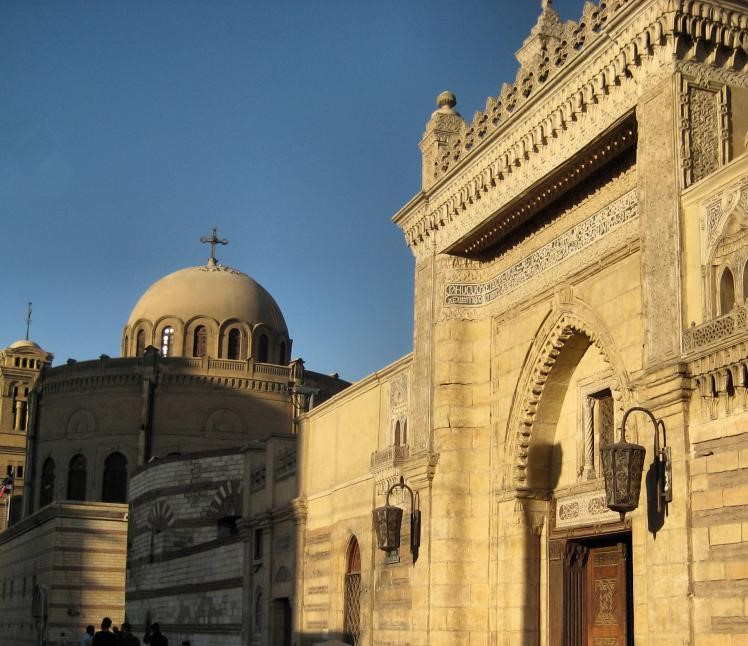Saint Barbara Church in Coptic Cairo
Where is Saint Barbara Church?
Saint Barbara church together with Abu Serga church, El Muallaqa church, and the Jewish Synagogue situated in Coptic Cairo in the Old Cairo district. The church of St Barbara is one of the many famous Coptic Orthodox churches in Cairo. Besides, the Church is located on the eastern part of the Babylon fortress and is one of the oldest buildings in Cairo, dating back to the 5th or 6th century AD.
Who was Saint Barbara?
St. Barbara was the daughter of one of the high-ranking wealthy men called Dioscorus. She was living with her father who loved her so much in Nicomedia, the capital of the Roman province of Bithynia (Asia Minor). She received a very high education in the best schools of art and science in the 3rd century AD. Her open mind and Enlighted heart led her to Christianity. She converted to Christianity because of the Egyptian priest Oreganos. Meanwhile, she refused to marry in order to devote her life to serving the religion that she converted to. Barbara offered herself completely to the Lord, choosing a life of consecrated virginity. Saint Barbara was martyred during the reign of the Roman Emperor Maximian (305-311).
Where did the name Barbara come from?
Barbara is a feminine name of Greek origin that means “foreign” or “strange,” derived from the Greek word Barbaros of the same meaning.
The church of St Barbara
It was a church strand north of the Coptic Museum and east of the church of saints Sergius and Bacchus (Abu Serga), on the eastern side of fort Babylon. The church was originally dedicated to Abu kir and Yohanna. When the remains of St. Barbara were brought here, a separate sanctuary was built. Thus, there are now two separate churches that were built in this location.
Who built the church of St Barbara?
Athanasius, the secretary of Abdelaziz ibn Marwan (governor of Egypt between 685 and 705 AD), had built the church. A door found during one of the church’s many restorations could date as early as the 4th century. Between 1072 and 1073, the church was fully restored to house the relics of Saint Barbara. These relics remain to this day.
Restoration work in the church of St Barbara
The church was damaged again by another fire during the 12th century. In fact, the church was renovated as recently as the beginning of the 20th century. when the khurus, a transverse room preceding the sanctuary, was sacrificed in order to allow more space.
Architecture
The church measure 26 meters long, 14.5 meters wide, and 15 meters high. The Basilican structure and tripartite sanctuary of the church closely resemble the one of Abu Serga.
There are two rows of five columns each separating the northern and southern aisles from the nave. The columns are joined by a finely carved wooden architrave.
Like most other Coptic orthodox churches that have more than one sanctuary, the middle sanctuary is one of main importance, dedicated to St. Barbara. After entering, from the narthex lobby, there are five marble columns that separate the nave from two aisles. In front of the middle sanctuary, there is a semicircular choir, which consists of 7 large steps. There are several other icons on the southern aisle of the church, representing the Virgin Mary and Jesus when he was a child, Jesus entering Jerusalem, and the baptism of Christ.
In the nave lies the ‘Mandatum Tank’ which was filled with water and used for the service of feet-washing on Maundy Thursday. Besides, on the Feast of Saints Peter and Paul, today a portable basin is used. Only the main sanctuary features an apse; the other two flanking it are rectangular rooms
Coptic Museum
Many important monuments were found in the Church of Saint Barbara and are now exhibited in the Coptic. Many of its precious items, like two door panels, a wooden screen, an icon, and Bible caskets were transferred to the nearby Coptic Museum. The church of St. Barbara houses some of the rarest icons and the relics of the Saint herself.
Restoration work at St Barbara
The Church of Saint Barbara like most of the churches in Coptic Cairo was destroyed by the two great fires of Fustat in the 8th and 12th centuries. it was rebuilt several times, most notably by the end of the 11th century.


Comment (0)